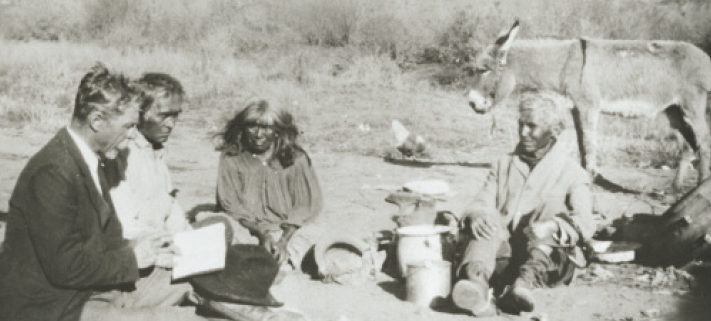Reaching Native Christians
WELS’ first missionaries to a foreign nation stepped off the train in Arizona determined to share the gospel with the Apache people.
Daniel J. Rautenberg and Debbie K. Dietrich
“This is the worst of times to begin an Indian mission.” So said a veteran missionary in 1876 as the Iowa synod was deciding whether or not to begin a gospel outreach effort to American Indians.
It certainly seemed like he was right. Days later General Custer and his men would die at the Battle of Little Bighorn. The next year an effort by the Joint Lutheran Synod to begin an Indian mission failed miserably when the missionary called to begin the work chose instead to focus on German Lutheran immigrants going to California. The Iowa Synod closed down its Indian mission. No other mission societies could be found to be partners in this venture. Time, money, and workers were lacking.
Then was the best time
But the desire to do mission work did not die. Undeterred by the obstacles, our forefathers continued to plan and work to begin their mission efforts. And when they found a group of people in Arizona unreached by the good news of the gospel, they decided that it was indeed the best time to bring the gospel message to the Apache Tribes in Arizona Territory.
In October of 1893, John Plocher and George Adascheck stepped off the train in Arizona Territory in what was then known as “Hell’s 40 Acres.” It was a harsh new environment. Desert heat without air conditioning. The strange barren landscape stretching in front of them foretold of isolation and loneliness. The only green things in sight seemed to be the missionaries.
As Rev. Alchesay Arthur Guenther, a longtime missionary to the Apache, wrote, “No real town. Just scattered small teepees or wikiups constructed of cedar poles covered with bear grass, tied with cactus rope. A tus (pitch covered basket) for carrying water, burden baskets for carrying corn, flour, salt, jerky, coffee, yucca bananas, wild onions, acorns, walnuts, and anything else. A scrawny horse and a couple of patient donkeys. Little ones with matted hair, bare feet and ragged clothing. These were to become his ‘congregation.’ Did this early white intruder from the East feel in his pocket for what just might be a return ticket?”
Aside from a theological education, the early missionaries were completely untrained for this new endeavor in this new culture. Their task was to preach the gospel to people who spoke a different language and had all the skepticism, cynicism, and hostility that comes from being defeated and betrayed. But the missionaries were determined to share the message of God’s love.
And they found people willing to listen. Try, fail, innovate, adapt, try again. Showing love, patience, and perseverance, our missionaries built a relationship with the Apache people. Over the last 125 years, not everyone who came to share the gospel could stay long. But the graveyards on both reservations pay silent tribute to those who did.
Now is the best time
One hundred twenty-five years later, not so silent tribute is paid every week by thousands of Native Americans who gather to offer praise to our gracious and merciful God! The powerful gospel has done incredible things on the Apache reservations in Arizona and continues to work in the hearts of fourth- and fifth-generation Christians. Children still fill the schools to learn about Jesus, and adults who were raised in the mission’s nursery are now leaders in the nine congregations. With more than 3,600 members, the Native American Mission now is raising up Apache men and women to take the gospel to their own people and, God-willing, to many other Native American tribes in the future.
We remember our history, because the attitudes displayed, lessons learned, and examples shown continue to guide and inspire us today! Not many of us will visit sick members after catching skunks and rendering their oil so that we can wrap our members in foul-smelling tar paper and torn flannel shirts like one of our early missionaries did! But we still show love and compassion. We may not have to live in a half cave with an Ocotillo cactus fence door or put together a house ordered from a Montgomery Ward catalog like those early missionaries, but we can improvise and innovate and find ways to do ministry and communicate the gospel. Most of all, we can, with the Holy Spirit’s help, always keep that fire to share the gospel burning bright. Despite the obstacles that Satan will put in front of us, our God is stronger and the Word of Life is powerful and urgently needed by more people.
So from your Native American brothers and sisters: A shoog’ (White Mountain Apache language), Ahi’ ye e’ (San Carlos Apache language). “Thank you!” to all of the WELS people today and to our ancestors 125 years ago who, undeterred by trials, take the gospel across the street, across the country, and across the oceans! We pray with you that we all use every opportunity to share the good news like the first world missionaries did 125 years ago—undeterred and fueled by the Holy Spirit, with new approaches and techniques, to new people, despite economic and political climates. “Now is the time of God’s favor, now is the day of salvation” (2 Corinthians 6:2).
May God bless all our efforts.
Daniel Rautenberg is the Native American Mission field coordinator. Debbie Dietrich is the Native American Mission communication coordinator.
This is the first article in a three-part series on WELS mission work on the Apache reservations in Arizona.
Reaching Native Christians series: part 1 | part 2 | part 3
SUBMIT YOUR STORY
Do you have a manuscript, idea, or story from your own life you’d like to share for use in Forward in Christ or on wels.net? Use our online form to share it to our editorial office for consideration.
SUBSCRIBE TO FORWARD IN CHRIST
Get inspirational stories, spiritual help, and synod news from Forward in Christ every month. Print and digital subscriptions are available from Northwestern Publishing House.
Author: Daniel J. Rautenberg and Debbie K. Dietrich
Volume 105, Number 4
Issue: April 2018
Copyrighted by WELS Forward in Christ © 2021
Forward in Christ grants permission for any original article (not a reprint) to be printed for use in a WELS church, school, or organization, provided that it is distributed free and indicate Forward in Christ as the source. Images may not be reproduced except in the context of its article. Contact us


